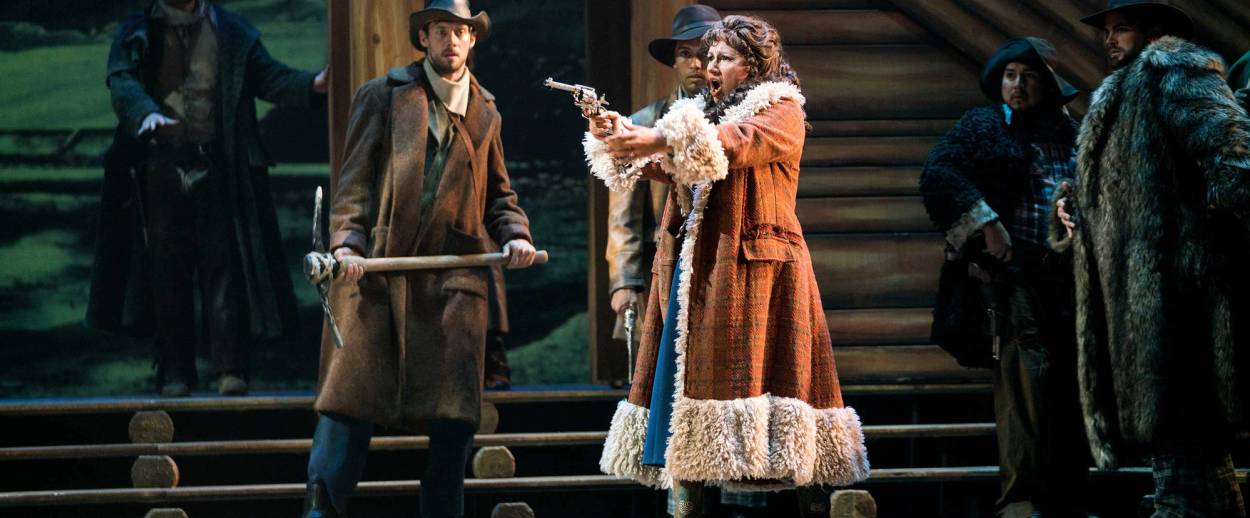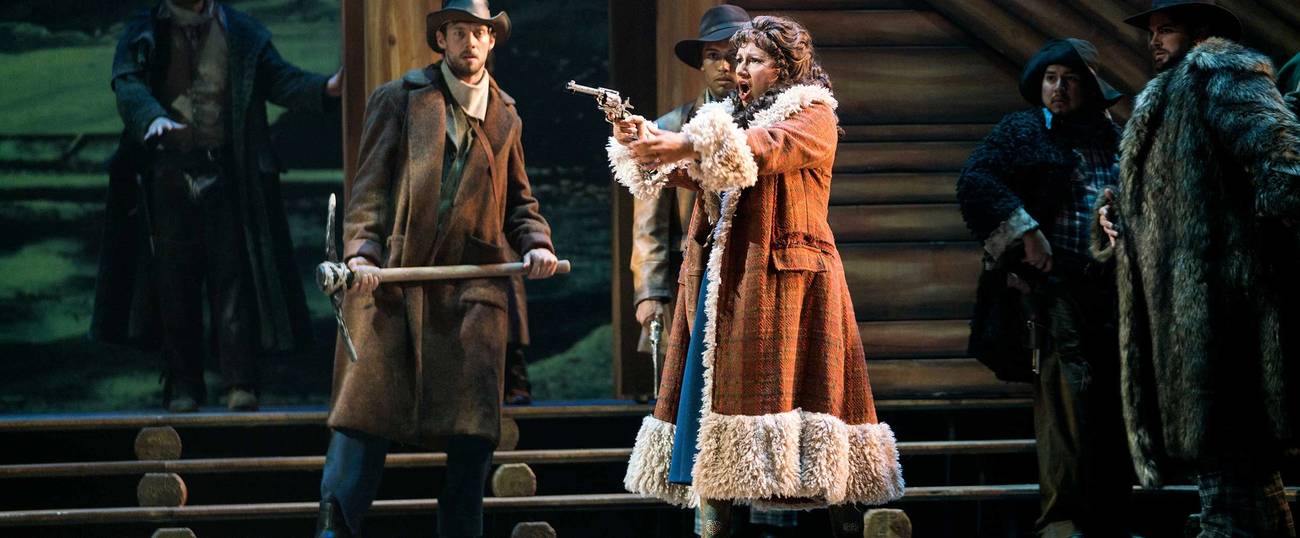A Golden ‘Girl of the West’
New York City Opera strikes it rich with Puccini’s ‘La Fanciulla,’ in a ‘triumphant’ return for the house of music of our humble European immigrant ancestors




The New York City Opera’s season premiere of Puccini’s La Fanciulla del West last week marked a triumphant return for a venerable company with a new sense of mission. Conductor James Meena led soprano Kristin Sampson in a stirring rendition of Puccini’s most challenging work at Lincoln Center’s Rose Theater, in an imaginative staging flawlessly executed. Long an also-ran to the Met, NYCO in its new incarnation offers a musical experience not otherwise available in New York — namely, top-of-the-line performances in a setting more intimate than the cavernous Metropolitan.
At 1,200 seats, the Rose Theater is smaller than Milan’s La Scala and barely larger than Teatro la Fenice in Venice. It was originally built as an opera house before it became the home of Jazz at Lincoln Center. The venue makes possible opera on a human scale and effective communication between singers and audience—a critical and underappreciated facet of the musical experience. Chamber music, for example, was written for the salon, not the theater, and the experience of hearing great performers in a room that seats two dozen people is entirely different from the same performers in Carnegie Hall. The same applies to opera. With 3,500 seats, the Metropolitan Opera is simply too big. So is the 2,800-seat Koch Theater, NYCO’s longtime venue. Frugally staged productions with unknown singers in small venues are available, to be sure—the Mannes Opera’s 2012 staging of Don Giovanni was the best I have ever heard—but they are hit-and-miss.
For the first time, the New York City Opera can do something that the Metropolitan cannot do, namely, offer New Yorkers the kind of musical experience that the great operatic composers intended. The emotional impact of Fanciulla is overwhelming at close range. The evening’s alpha pair, soprano Sampson as Minnie and tenor Jonathan Burton as the outlaw Dick Johnson, shine in some of the most difficult music in the repertoire.
With half a dozen major secondary roles and numerous comprimari, Fanciulla brawls through bar fights, lynch mobs, and revelry as well as love music. Sampson’s Minnie is tough and tender, reticent and violent, and utterly in command of the stage. Burton’s lyric tenor is pure and secure in all registers. Lack of control in the upper register is all that keeps the brilliant singing actor Kevin Short out of the first rank of operatic baritones.
***
Founded in 1943 as “the people’s opera,” in the words of Fiorello LaGuardia, NYCO made its mark by offering operatic staples at affordable prices for an audience that could not afford the Met. Italian, German, and Jewish immigrants bulked up its audience in an era when the Met had a multiyear waiting list for subscriptions. It performed at the old City Center on West 55th Street (where I first heard it in an English-language version of Gounod’s Faust in 1964) and then moved to what is now the Koch Theater at Lincoln Center. This followed the traditional European model of a prestigious opera company flanked by a popular theater that served as a farm team for younger singers. NYCO helped build the careers of scores of great singers, including its later general manager, the soprano Beverly Sills. Its theater was well-appointed, but enormous and rather cold, with rings of seats far removed from the stage.
The shrinking demographics of the opera audience during the early 2000s were not kind to the company. It was still the people’s opera, but the children of earlier immigrants lacked their parents’ passion for high European culture. In 1996 the Metropolitan earned 90 percent of its potential box-office revenue. By 2016, that figure had fallen to 66 percent. The Met now offers inexpensive rush tickets, and the old economic rationale for a minor-league company has vanished. Without tourists, I suspect, the Met would be in serious trouble.
Deeply in deficit, the City Opera sought a niche in contemporary and avant-garde opera under the brief directorship of George Steel. That is the sort of strategy that attracts institutional donors but repels audiences. By 2013, NYCO was out of business.
The company’s new general director, Michael Capasso, the founder of the intimate DiCapo Opera Company in New York, had a different vision. Capasso and board chairman Roy Niederhoffer relaunched the company in 2016 with a mixed offering of opera classics and new music. With the present season, the revived company has found solid footing: By offering a different kind of opera staging, Capasso can increase attendance among the existing opera audience.
Opera-goers who heard Fanciulla at the Metropolitan Opera back in 2011 with Deborah Voigt will, therefore, want to hear it again at NYCO, for a very different experience. While Puccini’s 1910 adaptation of David Belasco’s sentimental shoot-’em-up never won the hearts of American audiences as did La Boheme, Tosca, Madama Butterfly, or Turandot, it is not an entirely esoteric title: The Metropolitan Opera commissioned it at the advice of Arturo Toscanini, who conducted its premiere with Enrico Caruso in the tenor lead. The score is, in fact, far better than the earlier and more popular Puccini operas. It is more challenging than his last opera, Turandot, whose fairytale style and languid pace requires far less compositional ingenuity to propel the action forward. There is no better love duet in Puccini than the second-act exchange of the saloon-keeper Minnie and the outlaw Dick Johnson, and no more suspenseful moment than the poker game in which Minnie plays sheriff Dick Rance for the life of her lover.
Here Puccini borrows from Debussy to marvelous effect. Debussy is popularly called an impressionist, a term he called “imbecile.” His compositional technique often involves slowing down or even freezing the pace of harmonic motion, suspending musical lines in sustained chords that delay the musical resolution. In place of the standard Western tonal scale, Debussy frequently used the pentatonic scale familiar from Asian and some Western folk music, as well as sequences of whole tones, to the same effect. These musical techniques set the best-of-three-hands poker game between Minnie and the sheriff; if she loses, she will marry a man she hates, but she wins, Rance will leave her the man whom he has just shot and wounded.
But Fanciulla lacks a single tune that one whistles on the way out of the theater, and places enormous demands on the resources of opera companies. Although it was commissioned as an “American opera,” Puccini’s references to American popular culture are condescending, even jarring. In the first act, a banjo-playing balladeer sings a sentimental aria that is meant to recall Stephen Foster but is instantly recognizable as an Italian song colored with tonal gestures borrowed from Debussy.
Fanciulla shows how hard it is to bridge the gap between European high culture and the American popular audience, though when the Met commissioned the work in 1907, that is precisely what it had in mind. David Belasco was then America’s most popular playwright, and the Western theme seemed a sure winner among American audiences. Contrary to the Met’s best intentions, its audiences wanted Puccini to write operas about 19th-century Paris Bohemians or Italy in the age of Napoleon, rather than the California Gold Rush.
Various European composers have tried to write characteristically American Music, most successfully Antonín Dvořák, whose New World Symphony remains standard in the orchestral repertoire. In order to write American music, though, Dvořák first had to invent it. (There is distinctly American music; it comes from the Protestant hymnal.) The famous Largo of the “New World Symphony” is an original hymn tune subsequently adopted for church use. Dvořák’s work is the mother of all Western movie scores, beautiful and brilliant, but backward-looking and unambitious.
Puccini was willing to make no such concessions. Instead, he wanted to push the envelope of tonal techniques as applied to dramatic action. I do not think his experiment in Fanciulla is everywhere successful (the third act in particular drags, and ends on a sentimental religious note incongruent with the hard-edged emotions of the drama). But most of what Puccini accomplishes is arresting and original and often moving.
It was an inspired choice for NYCO, and a theatrical experience not elsewhere available. Rather than pander to an audience that doesn’t really like opera in the first place, NYCO took on a difficult opera with strong intimations of musical modernism and shot the lights out.
***
You can help support Tablet’s unique brand of Jewish journalism. Click here to donate today.
David P. Goldman, Tablet Magazine’s classical music critic, is the Spengler columnist for Asia Times Online, Washington Fellow of the Claremont Institute, and the author of How Civilizations Die (and Why Islam Is Dying, Too) and the new book You Will Be Assimilated: China’s Plan to Sino-Form the World.